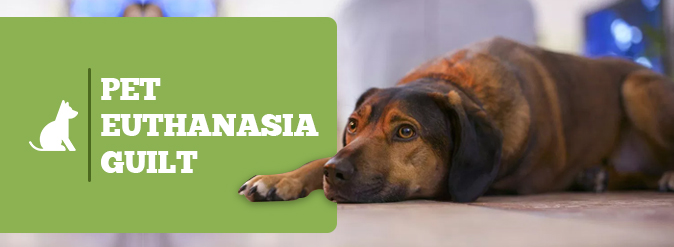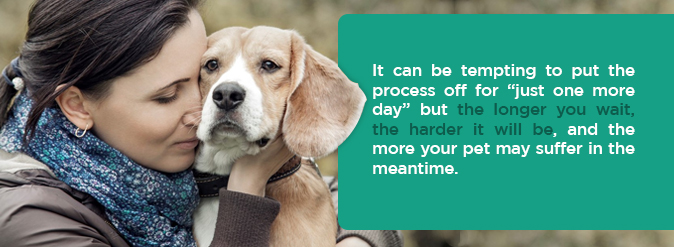 For pet owners, one of the hardest days of our lives is the day when we must decide to say goodbye to a beloved companion. Your pet has been there with you through the good days and the bad. Through it all, they’ve always been there to make you smile, cuddle you when you most need it and — let’s face it — make a mess as soon as you turn your back.
For pet owners, one of the hardest days of our lives is the day when we must decide to say goodbye to a beloved companion. Your pet has been there with you through the good days and the bad. Through it all, they’ve always been there to make you smile, cuddle you when you most need it and — let’s face it — make a mess as soon as you turn your back.
But life happens, and all of us know that our furry friends can’t stay with us forever. Whether your pet is growing old, is injured or in pain, or is becoming a danger to themselves or others, there comes a day when you’ll face the decision to let them go. This is never an easy choice, and many of us may wrestle with guilt for days, weeks and even months after we’ve already made the decision. We may ask ourselves, “Did I do the right thing by euthanizing my dog? What if I did it too soon? Should I have waited?”
If you’re having nagging thoughts like these, it’s important to know that they’re natural. Most pet owners who have been through a similar situation will have doubts like these, and they’re not a sign that you’ve done anything wrong. Today, we want to talk through how to cope with putting a dog down and how to come to terms with the fact that ultimately, you did the right thing. Even if it was hard.
What Happens When You Put a Pet to Sleep?
Once you’ve decided that it’s time to put your pet to sleep, it can be tempting to put the process off for “just one more day.” But the longer you wait, the harder it will be, and the more your pet may suffer in the meantime. Instead, resist this temptation and get busy preparing yourself, your family and your pet.
Pet Euthanasia Process
- Preparation
Check with your vet to see where they will do the procedure. Some vets only complete this process in their office, while others will be willing to come to your home. Figure out these plans ahead of time, and if you’re interested in having it done in the comfort of your own home, find a vet who will do so.Make sure everyone in the family has enough time to say goodbye and give your dog a few extra cuddles. If you have young children, it’s especially important to sit them down and explain in gentle, child-friendly terms what’s happening. They will likely have difficult questions that you may not know how to answer, so spend some time thinking about what you’ll tell them and how. While this conversation may be difficult, it’s essential to have if your child is going to be able to accept the loss of their friend in a healthy way.Finally, if you’re headed to the vet’s for the process, consider bringing your pet’s favorite blanket or pet bed with you. The vet will certainly provide a blanket, but it can be an extra comfort to your dog to have the familiarity of their favorite items with them at this time. - Procedure
The procedure is easy and uncomplicated. First, the doctor will get your pet settled and comfortable. Many times, it’s best if you sit with your pet so you can comfort them and keep them calm throughout the process. The vet may choose to give your pet a sedative to prevent them from moving around or fighting to get away from you. In some cases, if the pet is very old or sick, however, this may not be necessary.Once your pet is sedated, the vet will administer the shot. While the contents of the shot may vary, most vets use pentobarbital, a seizure medication that will easily make an animal fall unconscious when given in large doses. The vet will administer the medication through an IV into one of the pet’s legs. Your dog will first fall unconscious before their heart and brain functions gently shut down after a few moments.As the pet goes to sleep, they may make small, involuntary movements, and their eyes may not close fully. They may even urinate. These are all normal reactions and aren’t a sign that your pet is in pain or that something unusual is happening. - Post-Procedure
Once the procedure is finished, the next steps involve figuring out how to lay your beloved friend to rest. If you plan to bury them at home, be sure to check local regulations to be certain this is legal. Pet cemeteries are also an option worth looking into. Additionally, pet cremation is a route many people choose. Decide which option is best for you and your pet and move forward from there.

Do Pets Suffer When They’re Put to Sleep?
No.
One of the most common questions that pet owners have when they consider the option of putting their pet to sleep is, “Will my pet suffer?” It’s an understandable question, as most of us assume that death in any form is painful.
The truth is that euthanasia is painless for animals. For them, it feels like nothing more than drifting off to sleep. If your pet is sick or suffering from an injury or long-term disease, this process of being put to sleep may even feel like a relief for them. They’ve likely been suffering for a while now, and thanks to this painless process, they can finally stop feeling pain.
If you’re worried about your pet feeling pain during the process, know that everyone has this same worry. More importantly, realize that while this concern is natural, it’s ultimately unfounded, as your pet will feel nothing at all but the gentle process of falling asleep.
Did I Put My Pet to Sleep too Soon?
In some cases, the choice to euthanize is not a choice at all, but a necessity. A pet has been severely injured and is suffering horribly, or perhaps is at the end of a long disease. In cases like these, no matter how much we love our pets, we understand that euthanasia is better than continued suffering.
Other times, the choice is less clear. We may know there is a good reason to choose euthanasia, but perhaps your pet is still alert and mobile enough that it seems like an extreme option. For this reason, we hesitate, worrying that we might take this path before it was truly necessary. On the other hand, none of us would ever want to prolong a pet’s suffering.
How can you know when the right time is? Is there ever a way to know? Here are just a few of the most common reasons pet owners choose to take this final step for their companions.
When to Put Your Pet Down
- Poor health: If your pet is battling an extreme illness, they are likely suffering a great deal. Getting up every day, moving around and even just lying down can be painful. In cases where your pet’s quality of life is low, the greatest kindness you can give to your pet is the gift of peaceful sleep.
- In pain: If a pet takes a bad fall and injures themselves, particularly if your pet is already old and in declining health, this can be cause for euthanasia. The odds of the injury healing properly may be slim, meaning your pet will spend the rest of their life in pain, or not be able to get around properly. Often, the best thing you can do is let them avoid these months or years of pain altogether by having them put to sleep.
- Aggression problems: If your pet has been developing aggression problems towards other people or animals, euthanasia is sometimes the recommended option. If they can’t be trained out of their aggression, they won’t be safe to have around other people or even other pets, meaning their only option is to spend their life in a shelter, and even that may not be possible. In cases like these, euthanasia may be the best option.
- Exhausted all options: Circumstances change. Maybe you adopted a pet only to realize someone in your family is extremely allergic. Maybe your pet developed a health condition you don’t have the money to treat. Maybe you’re moving someplace that doesn’t allow pets, and no relatives, friends or shelters can take your pet. It may not feel like it at the moment, but putting your pet to sleep is a far kinder and more respectful solution than simply abandoning your pet, making it the best choice when there are no other viable options.

If any of these factors are at play in your case, it may be time to consider if euthanasia is the right option for you. And if you’re still struggling with whether it’s too soon or whether you should keep trying other options first, consult with your local vet. They’ll help walk you through the process and can advise you if putting your pet to sleep is truly the best option.
Old Pets vs. Young Pets
The reasons for putting an older pet to sleep vs. a younger one are often different. Older pets are more likely to be put to sleep because of an injury or illness than younger pets, for instance. This is because young pets usually have their good health, and can better bounce back after an injury, while an old dog would only suffer. Young pets, however, are more likely to be put to sleep for something like aggression, or an impossible situation where there’s no one to care for them anymore.
In addition to the reasons for euthanasia differing based on a pet’s age, often our feelings about the process can be different depending on how old our pet was. If we have to put a pet down who has already lived a long life, we will still feel sad, but the guilt will often not be as strong. We can comfort ourselves by realizing that our pet wouldn’t have lived much longer anyway, and has already enjoyed a good life. With younger pets, however, the guilt can often be stronger because we know that ideally, this animal should still have years of life ahead of it.

When these feelings crowd in, try to remember that just because your pet might still have years ahead of it, they wouldn’t necessarily be good years. If your pet’s quality of life is so low that he is constantly miserable and unable to enjoy any of his favorite activities, prolonging that life may not be worth it. In cases like these, the best way to treat your friend with dignity and respect is to let him go to sleep now instead of continuing to live for years with a low quality of life.
Managing Guilt From Pet Euthanasia
Are you feeling guilty about euthanizing your dog? You’re not alone. Everyone who’s ever had to make this hard call has likely felt guilt as they faced this situation. It’s not a sign that you’ve done anything wrong or that you’re somehow weak for being emotionally impacted by your pet’s departure. After all, you and your pet were close. Feeling guilt is a sign of just how much you cared about your pet.
Guilt is our brain’s way of protecting us feeling the full weight of our grief and sadness over something like loss. As long as we’re feeling guilty, our emotions and thoughts are busy in the past, thinking things like, “What if I had done things differently? What if I made the wrong call?” As long as we’re having these thoughts, we’re distracted from how much we miss our pets.
But the truth is that if you consulted a vet and spent hours or days thinking over the decision, there’s nothing more you could have done, and you can feel confident that you made the right decision, even though it was hard. Try to catch yourself when you find the guilty thoughts creeping in. When your brain tells you, “You made the wrong decision,” make the conscious choice to respond with, “No, I didn’t. My pet was in pain, and I chose to help her.”
It isn’t easy, but when your thoughts turn towards guilt and self-imposed mental punishment, try to be kind to yourself. Remind yourself that even though you weren’t perfect, you loved your pet dearly and would never hurt him. You made your decision out of kindness and necessity. Remind yourself of the good times with your pet. Remember how much they loved and trusted you. And try to forgive yourself. The guilt may not disappear immediately, but by reminding yourself the truth of your decision, it will surely recede over time.
Remember that if you find yourself needing more support in this difficult time, there’s no shame in this. Many grief support groups and even counselors specialize in pet loss and grief. Reaching out to one of these may be the right choice and can help you lay your grief to rest.
Reach out to Agape With Your Questions Today

Deciding to euthanize a pet is never an easy one, and saying goodbye to a pet will always hurt. But the decision can become less confusing and scary when you understand the way the process works and what will happen afterward. If you have any questions about putting your pet to sleep and how to respectfully lay your pet to rest afterward, then don’t hesitate to reach out to us here at Agape Pet Services.


